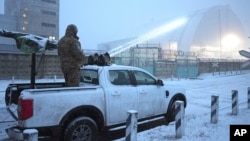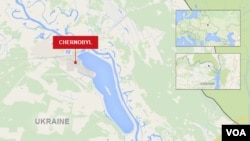The U.N.’s International Atomic Energy Agency (IAEA) confirmed Friday that a drone attack damaged an outer wall of the protective dome containing the remains of the damaged Chernobyl nuclear reactor in Ukraine, starting a fire. The 1986 Chernobyl nuclear accident is considered the worst in history.
Ukraine blames Russia for the attack on the site located about 130 kilometers north of Kyiv, which Moscow denies.
In a statement on the IAEA website, the agency’s team based at the site reported hearing an explosion at 1:50 a.m. local time. They said smoke and fire were visible from the team’s on-site dormitory.
Ukrainian officials informed the team a drone struck the New Safe Confinement (NSC) structure built to prevent a radioactive release from Chernobyl’s damaged reactor and protect it from external hazards.
The team reported that firefighters and vehicles arrived at the scene within minutes to begin extinguishing the blaze, which, they said, could be seen intermittently for several hours afterward.
The team said it observed a breach in the outer layer of the containment structure caused when the drone exploded on impact. Ukraine’s nuclear regulatory officials Friday confirmed the outer covering of the protective dome sustained damage, and investigations are ongoing to determine the extent of the damage to the interior.
The IAEA said radiation levels inside and outside the NSC building remain normal and no casualties were reported. But agency Director-General Rafael Grossi said the incident was “deeply concerning,” and said it “underlines the persistent risks to nuclear safety during the military conflict.”
An explosion and fire in April 1986, at the Chernobyl nuclear power plant destroyed the reactor building and released large amounts of radiation into the atmosphere. A U.N. report said 31 people died immediately from the explosion, and while the exact number of people who died from subsequent radiation exposure is in dispute, the U.N. reports nearly 8.4 million people in Belarus, Russia and Ukraine were exposed to radiation due to the widespread radioactive fallout.
Speaking to reporters Friday, Kremlin spokesperson Dmitry Peskov denied Russian involvement saying Russia does not conduct strikes on nuclear infrastructure. He called Ukraine’s claim’s “a provocation.”
Fighting around nuclear power plants, including the Zaporizhzhia nuclear power plant, Europe’s largest, located near the battle zones in southeastern Ukraine, has repeatedly raised fears of a nuclear catastrophe during three years of war.
Some information for this report came from The Associated Press, Reuters and Agence France-Presse.









